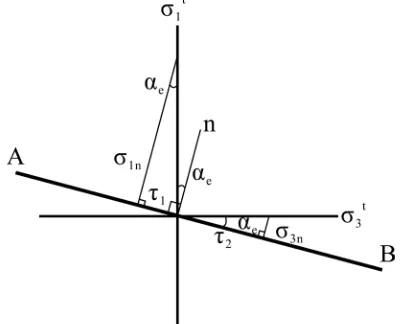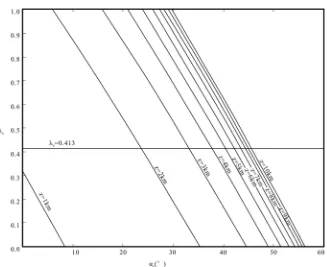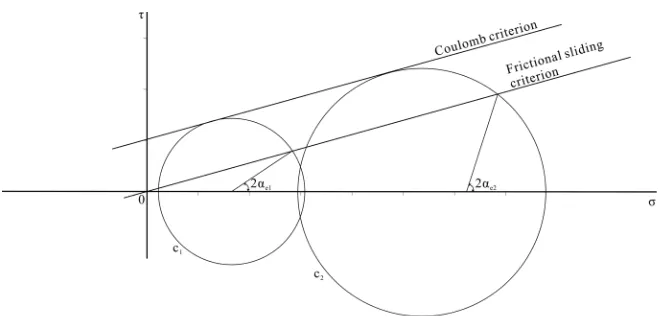ISSN Print: 2160-049X
DOI: 10.4236/wjm.2018.85016 May 28, 2018 210 World Journal of Mechanics
On the Reactivation of the Pre-Existing Normal
Fault
Shuping Chen
1, Zongpeng Chen
21State Key Laboratory of Petroleum Resource and Prospecting, China University of Petroleum, Beijing, China 2Jackson School of Geosciences, University of Texas at Austin, Austin, USA
Abstract
The reactivation of pre-existing faults is a common phenomenon in a basin. This paper discusses the relationship between the pre-existing faults and the newly formed Coulomb shear fractures regarding pore fluid pressures. Based on the Coulomb fracture criterion and Byerlee frictional sliding criterion, an equation relating pore pressure coefficient (λe), minimum dip angle (αe) of the reactive pre-existing fault and the intersection point depth (z) between the pre-existing fault and a newly formed Coulomb shear fault in an extensional basin, is established in this paper. This equation enhanced the understanding on the reactivation of pre-existing faults and can be used to calculate pa-leo-pore fluid pressures. The bigger the pore fluid pressure in a pre-existing fault is, the less the minimum dip angle for a reactive pre-existing fault will be. The minimum dip angle is less in shallow area than that in deep area. This will be of significance in petroleum exploration and development.
Keywords
Coulomb Criterion, Frictional Sliding Criterion, Pre-Existing Fault, Pore Fluid Pressure, Reactivation
1. Introduction
The reactivation of pre-existing faults is a common phenomenon in a basin [1] (Twiss & Moores, 2007). Pre-existing faults may controlled the geometry and evolution of a rift [2] [3] [4] and after that, pre-existing faults may be abandoned and be cross-cut by newly formed structures [5] [6] to become sealing for oil and gas [7] [8]. In map view, pre-existing faults may reactivate where the stretching direction changes by less than 45˚ between extension events [9]. In cross sec-tions, the minimum angle of a reactive fault and its sealing property for oil and
How to cite this paper: Chen, S.P. and Chen, Z.P. (2018) On the Reactivation of
the Pre-Existing Normal Fault. World
Journal of Mechanics, 8, 210-217.
https://doi.org/10.4236/wjm.2018.85016
Received: April 8, 2018 Accepted: May 25, 2018 Published: May 28, 2018
Copyright © 2018 by authors and Scientific Research Publishing Inc. This work is licensed under the Creative Commons Attribution International License (CC BY 4.0).
DOI: 10.4236/wjm.2018.85016 211 World Journal of Mechanics gas has been discussed [8]. However, both the details on reactivation of pre-existing faults and the pore fluid pressures have seldom addressed [1] [10]. Based on the Coulomb fracture criterion (also called the Navier-Coulomb, Mohr-Coulomb or Coulomb-Mohr fracture criterion) [11] and the Byerlee fric-tional criterion [12], this paper is to discuss the controlling factors of the mini-mum dip angle of a pre-existing fault thus helping understand the reactivation in pre-existing faults and forecast the paleo fluid pressure in faults.
2. Methodology
Coulomb criterion or frictional sliding criterion is applicable in most of the de-formation in the upper lithosphere which always is shown as:
0 tan
o n n
τ τ= +µσ =τ + φσ (1) where τo is cohesion, μ is coefficient of internal friction, ϕ is internal frictional angle and σn is effective normal stress [13] [14].
In terms of the principal stresses, the Coulomb criterion for normal faults can be written to be [15]
(
)
1 gz 1
σ
=ρ
−λ
(2)and
(
)
1 3
1 1
K gz S
K K
σ σ− = − ρ −λ + (3)
with
2 sin 2 1 cos 2
,
1 cos 2 1 cos 2
o f f
f f
S τ θ K θ
θ θ
−
= =
+ + (4)
and
2
θ
f =90+φ µ
, =tanφ
(5)where K is a parameter depending on the fracture angle; S is the fracture strength under uniaxial compression with zero confining pressure; θf is the frac-ture angle; ϕ is the internal friction angle and λ is pore fluid pressure coefficient, the ratio of pore pressure to overburden pressure. In a rift basin, the maximum stress is vertical and the pore fluid pressure coefficient is [16]
P gz
λ ρ
= (6)
where P is pore fluid pressure, ρ is density of overlying rocks, g is gravity accele-ration and z is depth.
For a pre-existing fault, its cohesion is zero and the frictional sliding criterion, for the same rocks becomes to be
tan
n n
τ µσ= = φσ (7)
DOI: 10.4236/wjm.2018.85016 212 World Journal of Mechanics pressure is less than or larger than 200 MPa in Byerlee’s law.
Under the stresses σ1 and σ3, corresponding to total stresses
σ
1t andσ
3t, the pre-existing faults with their normal lines within the ΔOLM (Figure 1) will reactivate where a newly Coulomb shear fracture occurs. In an extensional basin with a vertical maximum principal stress, the reactive pre-existing fault with the minimum dip angle matches point L (Figure 1) and is supposed to be the line AB (Figure 2) with a pore pressure coefficient λe.The normal stress on the fault AB is
1tcos 3tsin 1t
n e e e
σ
=σ
α σ
+α σ λ
− (8)with
(
)
1 3
1
, 1
t gz t gz K S
K K
[image:3.595.208.540.192.477.2] [image:3.595.273.473.513.675.2]σ =ρ σ = ρ − +λ λ − (9)
Figure 1. Coulomb fracture criterion and frictional sliding criterion for the same rock.
Figure 2. Stress state of a reactive fault AB with the minimum dip angle of αe. σ1t is total
maximum principal stress and it is vertical. σ3t is total minimum principal stress and it
DOI: 10.4236/wjm.2018.85016 213 World Journal of Mechanics The shear stress on the pre-existing fault AB is
1tsin e 3tcos e
τ σ
=α σ
−α
(10) According to Equation (7), we have(
σ
1tsinα σ
e− 3tcosα
e) (
=µ σ
1tcosα σ
e+ 3sinα σ λ
et− 1t e)
(11) Given ρ = 2.7 g/cm3, ϕ = 30˚, τ = 23 Mpa, g = 10 m/s2 and λ = 0.413 (a salt water density of 1.073 g/cm3 is assumed), in terms of the Equations (4) and (5), we get79.67, 3
S= K= (12) In terms of the Equations (2) and (7), we get
1t 27z
σ
= (13)and
3t 16.43z 26.56
σ
= − (14) where the unit ofσ
1t andσ
3t is MPa and that of z is km. The depth z is de-fined to be the depth of the intersection point between a pre-existing fault and a newly formed Coulomb fracture (Figure 3).Substituting Equations (13) and (14) into Equation (11) and considering μ = tan 30˚ = 0.577, we get
1.71cos 1.03sin
2.03cos 1.14sin e e
e e e z
α α
λ = α − α − + (15)
3. Implication of the Equations
According to Equation (15) we know that there is a specific relationship between the pore fluid pressure (λe) and the minimum dip angle (αe) in a reactive pre-existing fault and the intersection depth (z) between the pre-existing fault and a newly formed Coulomb shear fault. The pore pressure coefficient is ra-tional in the range of 0 to 1 and the minimum dip angle is rara-tional in the range of 0˚ - 60˚. For a typical rock with an inner frictional angle of 30˚, the dip angle of a normal fault, a Coulomb shear fracture with a maximum vertical stress and a minimum horizontal stress, is 60˚. As shown in Figure 4, the relation between λe and αe is close to linear. We can get one of the three parameters like z, λe and
[image:4.595.217.529.587.688.2]αe in terms of the Equation (15) or Figure 4.
Figure 3. A reactive pre-existing fault with minimum dip angle and a newly formed
Coulomb shear fracture with a dip angle αi that is 45 2
i
DOI: 10.4236/wjm.2018.85016 214 World Journal of Mechanics
Figure 4. Coefficient of pore fluid pressure vs. minimum dip angle for pre-existing fault
for various depthes.
For the cases with the same intersection depth of z, the pore fluid pressure coefficient in a reactive pre-existing fault will decrease with the increase of the minimum dip angle for the pre-existing fault (Figure 4). The less the minimum dip angle of a reactive pre-existing fault is, the bigger the pore fluid pressure coefficient in a reactive pre-existing fault is.
Sharing the same dip angle, the bigger the intersection depth of z is, the bigger the pore fluid pressure coefficient is. Similarly, when pore pressure coefficient keeps the same, the minimum dip angle for reactivating a pre-existing fault will increase with the increase in the intersection depth z (Figure 4). This can be further explained based on Figure 5. The maximum principal stress in vertical direction will increase with increasing depths, which mean increasing confining pressures. In turn, the differential stress needed to form a Coulomb shear frac-ture will increase with increasing depths or confining pressures. The minimum reactive dip angles (αe1) of pre-existing faults in less confining pressure is less than those (αe2) in higher confining pressure.
4. Discussion
DOI: 10.4236/wjm.2018.85016 215 World Journal of Mechanics
Figure 5. Coulomb shear fractures and reactive pre-existing faults with increasing
confining pressure or depth in an extensional basin. αe1 and αe2 are minimum reactive dip angles of pre-existing faults in less confining pressure and higher confining pressure. αe1 < αe2.
occurrence of new Coulomb fractures will be accompanied by reactivation of pre-existing faults to form fluid flowage paths [8] [10] [21]. However, the Cou-lomb fracture criterion cannot explain the normal faults with dip angles less than 45˚ in an extensional basin with a vertical maximum principal stress (σ1). The angle relationship between the fault dip and the maximum principal stress (σ1) is not involved in the Byerlee frictional sliding criterion. Seldom work has been addressed on the effect of pore fluid pressures [1] [10] [20] [22] [23]. Fur-thermore, little has been addressed on the dip change of a reactive pre-existing fault with increasing depth.
In terms of the Equation (15) and based on the analysis in section of implica-tion of the equaimplica-tions, the effect of pore fluid pressures on the reactivaimplica-tions of pre-existing faults can be addressed. A high pore fluid pressure will decrease the minimum dip angles of reactive pre-existing faults. Paleo fluid pressure would be calculated and this will be helpful in determining fault sealing property. On the other hand, the minimum dip angles of reactive pre-existing faults will in-crease with the increasing depth in an extensional environment where the max-imum principal stress is vertical (Figure 5). Both the confining pressures and differential stresses needed to form Coulomb shear faults will increase with depths. This will explain both the increasing dip angles upward the pre-existing faults and the fault branching downward the pre-existing faults.
5. Conclusion
DOI: 10.4236/wjm.2018.85016 216 World Journal of Mechanics normal faults. The first is that the pore fluid pressures affect the reactivations of pre-existing faults. A high pore fluid pressure will decrease the minimum dip angles of reactive pre-existing faults. This is of significance in petroleum explo-ration. The second is that the minimum dip angles of reactive pre-existing faults will increase with the increasing depth in an extensional environment. This is of significance in explaining some downward branching faults and some upward steepening faults.
Acknowledgements
This study is financially supported by the National Natural Science Foundation of China (No. 41572105, 41172124) and the Strategic Priority Research Program of the Chinese Academy of Sciences (Grant No. XDA14010306).
References
[1] Twiss, R.J. and Moores, E.M. (2007) Structural Geology. W. H. Freeman and Com-pany,New York.
[2] Naliboff, J. and Buiter, S.J.H. (2015) Rift Reactivation and Migration during Multi-phase Extension. Earth and Planetary Science Letters, 421, 58-67.
https://doi.org/10.1016/j.epsl.2015.03.050
[3] Phillips, T.B., Jackson, C.A., Bell, R.E., Duffy, O.B. and Fossen, H. (2016) Reactiva-tion of Intrabasement Structures during Rifting: A Case Study from Offshore Southern Norway. Journal of Structural Geology, 91, 54-73.
https://doi.org/10.1016/j.jsg.2016.08.008
[4] Claringbould, J.S., Bell, R.E., Jackson, C.A.L., Gawthorpe, R.L. and Odinsen, T. (2017) Pre-Existing Normal Faults Have Limited Control on the Rift Geometry of the Northern North Sea. Earth and Planetary Science Letters, 475, 190-206.
https://doi.org/10.1016/j.epsl.2017.07.014
[5] Thomas, D.W. and Coward, M.P. (1995) Late Jurassic-Early Cretaceous Inversion of the Northern East Shetland Basin, Northern North Sea. Geological Society, 88, 275-306. https://doi.org/10.1144/GSL.SP.1995.088.01.16
[6] Bell, R.E., Jackson, C.A-L., Whipp, P.S. and Clements, B. (2014) Strain Migration during Multiphase Extension: Observations from the Northern North Sea. Tecton-ics, 33, 1936-1963. https://doi.org/10.1002/2014TC003551
[7] Zhang, Y., Underschultz, J.R., Gartrell, A., Dewhurst, D.N. and Langhi, L. (2011) Effects of Regional Fluid Pressure Gradients on Strain Localisation and Fluid Flow during Extensional Fault Reactivation. Marine and Petroleum Geology, 28, 1703-1713. https://doi.org/10.1016/j.marpetgeo.2011.07.006
[8] Chen, S.P., Xu, S.S., Wang, D.R. and Tan, Y.M. (2013) Effect of Block Rotation on Fault Sealing: An Example in Dongpu Sag, Bohai Bay Basin, China. Marine and Pe-troleum Geology, 39, 39-47.https://doi.org/10.1016/j.marpetgeo.2012.10.002
[9] Henza, A.A., Withjack, M.O. and Schlische, R.W. (2010) Normal-Fault Develop-ment during Two Phases of Non-Coaxial Extension: An ExperiDevelop-mental Study. Jour-nal of Structural Geology, 32, 1656-1667. https://doi.org/10.1016/j.jsg.2009.07.007
[10] Chen, Z.G. (1986) Rock Mechanic Property and Tectonic Stress Field. Geological Publishing House, Beijing.
[11] Fossen, H. (2010) Structural Geology. Cambridge University Press, Cambridge.
DOI: 10.4236/wjm.2018.85016 217 World Journal of Mechanics [12] Byerlee, J. (1978) Friction of Rocks. Pure and Applied Geophysics, 116, 615-626.
https://doi.org/10.1007/BF00876528
[13] Hubbert, M.K. and Rubey, W.W. (1959) Role of Fluid Pressures in Mechanics of Overthrust Faulting: I. Mechanics of Fluid-Filled Porous Solids and Its Application to Overthrust Faulting. GSA Bulletin, 70, 115-166.
https://doi.org/10.1130/0016-7606(1959)70[115:ROFPIM]2.0.CO;2
[14] Cloos, M. and Sapiie, B. (2013) Porphyry Copper Deposits: Strike-Slip Faulting and Throttling Cupolas. International Geology Review, 55, 43-65.
https://doi.org/10.1080/00206814.2012.728699
[15] Schellart, W.P. (2000) Shear Test Results for Cohesion and Friction Coefficients for Different Granular Materials: Scaling Implication for Their Usage in Analogue Modeling. Tectonophysics, 324, 1-16.
https://doi.org/10.1016/S0040-1951(00)00111-6
[16] Secor, D.T. (1965) Role of Fluid Pressure in Jointing. American Journal of Science, 263, 633-646. https://doi.org/10.2475/ajs.263.8.633
[17] Mackay, M.E. (1995) Structural Variation and Landward Vergence at the Toe of the Oregon Accretionary Prism. Tectonics, 14, 1309-1320.
https://doi.org/10.1029/95TC02320
[18] Paterson, M.S. (1978) Experimental Rock Deformation: The Brittle Field. Sprin-ger-Verlag, New York. https://doi.org/10.1007/978-3-662-11720-0
[19] Davis, D., Suppe, J. and Dahlen, F.A. (1983) Mechanics of Fold-and-Thrust Belts and Accretionary Wedges. Journal of Geophysical Research, 88, 1153-1172.
https://doi.org/10.1029/JB088iB02p01153
[20] Xiao, H. and Suppe, J. (1991) Mechanics of Extensional Wedges. Journal of Geo-physical Research, 96, 10301-10318. https://doi.org/10.1029/91JB00222
[21] Morley, C.K., Haranaya, C., Phoosongsee, W., Pongwapee, S., Kornsawan, A., et al. (2004) Activation of Rift Oblique and Rift Parallel Pre-Existing Fabrics during Ex-tension and Their Effect on Deformation Style: Examples from the Rifts of Thail-and. Journal of Structural Geology, 26, 1803-1829.
https://doi.org/10.1016/j.jsg.2004.02.014
[22] Dahlen, F.A. (1984) Noncohensive Critical Coulomb Wedges: An Exact Solution. Journal of Geophysical Research, 89, 10125-10133.
https://doi.org/10.1029/JB089iB12p10125
[23] Dahlen, F.A. (1990) Critical Model of Fold-and-Thrust Belts and Accretionary Wedges. Annual Review of Earth and Planetary Sciences, 18, 55-99.



